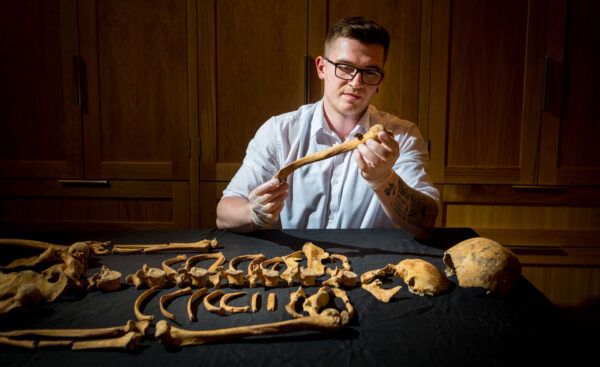Archeologists carrying out an excavation inside the Tower of London have uncovered the body of two skeletons, of an adult female and a young child. The excavations took place just outside the Chapel of St Peter ad Vincula, a small church within the Tower grounds, in preparation to provide better disabled access into the chapel.
The chapel was completed in 1520 and as a Chapel Royal is still a place of Christian worship, it is perhaps most famed for being the final resting place of two of King Henry VIII’s six wives, Anne Boleyn and Catherine Howard, as well as the burial site for many of the ‘traitors’ beheaded on nearby Tower Hill.
During the preparation works, archaeologists from Pre-Construct Archaeology dug two trial digs in order to gather information on the chapel’s boundaries and that of associated burials within its grounds. It was during these excavations that a burial site was discovered.
Under an existing entrance to the chapel, beneath the remains of what appears to be an earlier chapel located on the site, were two burials. The skeletons of an adult female and a young child, were found cut into the remnants of a medieval floor.
The remains were found lying on their backs facing up or ‘supine’ and were aligned with their feet facing east, typical of a Christian burial. Due to the presence of coffin nails, and the positioning of the skeletons, it is thought that the adult female was buried within a coffin whilst it is likely the child was simply wrapped in a blanket or ‘shrouded’ prior to being buried. These are typical of later medieval and early Tudor burials and due to further materials and artefacts uncovered it seems likely that these remains were laid to rest sometime between 1450 and 1550 – between the Wars of the Roses and the reign of King Henry VIII’s short lived son, Edward VI.
Although no artefacts were found with the skeletons, the remains have done much to inform curators and historians about life at the Tower.
They are the first complete remains to be uncovered at the fortress since the 1970s and are the first full skeletons found within the grounds to be assessed by an osteoarchaeologist (bone specialist). By looking for marks related to growth, damage, wear and disease curators have been able to create an image of how these individuals lived and died.
The female is considered to be between the ages of 35-45 while the child is thought to have been around 7 years of age. Both skeletons show signs of illness and the adult shows signs of chronic back pain. Their growth shows that they did not have a comfortable life, but this was relatively ordinary in the period in which they lived. Furthermore, there are no signs of a violent death concerning either individual leading curators to believe that the chapel burial ground was also used for those who lived and worked within the Tower of London.
Alfred Hawkins, Curator Historic Royal Palaces, said: “This excavation has brought to light new information and artefacts that have the potential to completely change how we think about the evolution of the Chapel of Saint Peter ad Vincula. Whilst archaeologists exhume skeletons across hundreds of sites around the UK every day – these two individuals do stand out. As the first complete remains to be examined from within this royal fortress, they have offered us a chance to glimpse that human element of the Tower which is so easy to miss.”
The remains have now been reinterred in the chapel during a special ceremony conducted by the Tower of London chaplain, The Reverend Canon Roger Hall.







